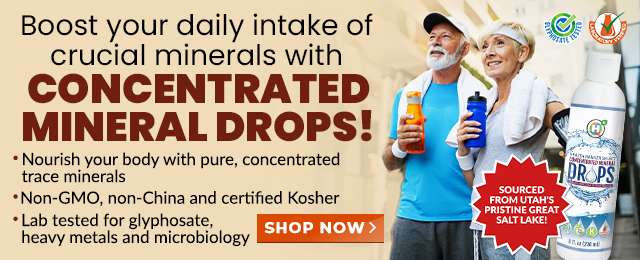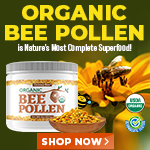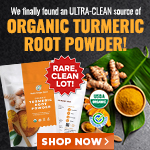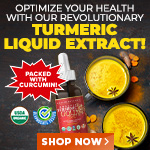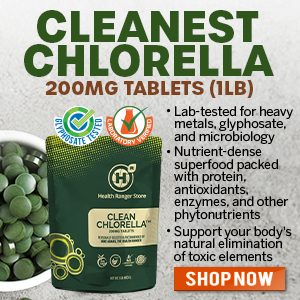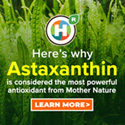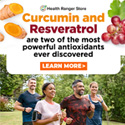Oxygenate your cells to avoid disease-causing inflammation - here's how
Monday, January 26, 2015 by: Ethan A. Huff, staff writer
Tags: oxygen deficiency, nutrition, exercise

- New study links mRNA vaccines to GENETIC CHANGES - and not the good kind
- Fauci is back in the limelight, and he’s busy promoting a future COVID or FLU pandemic
- Tulsi Gabbard leads charge against the Biden regime’s global censorship of the 'Disinformation Dozen'
- A comprehensive guide to DANDELIONS, an ancient herbal medicine and superfood
- DEADLY FLU JAB WARNING: New flu vaccines make recipients 27 PERCENT MORE LIKELY to catch the flu
- Aerosolized bioweapons? Strange “diploid biomasses” falling out of the sky in Florida captured under the microscope
- How Israeli military-connected corporations are secretly controlling your online privacy
- Idaho Gov. Brad Little signs Medical Freedom Act banning vaccine mandates
- Analysis: The coming economic collapse, a mass uprising and Trump's three secret weapons to halt the growing revolt
- Kiss Your Genetic Privacy Good-Bye! 23andMe Gets Green Light to Sell Your Intimate Genetic Details to Anyone They Want
- U.S. lawmakers investigate Meta over alleged China collaboration
- DEATH BY DOCTOR: Why and how doctors are now PAID TO KILL their patients
- Tulsi Gabbard takes aim at censorship: Justice for the ‘Disinformation Dozen’
- Widespread social and economic unrest: Steve Quayle issues urgent financial warning of imminent asset collapse in new interview with Mike Adams
- Curcumin’s ancient healing power supercharges muscle recovery, and its effects are compounded with anti-inflammatory foods and supplements
- CIA Official Terry Adirim TERMINATED for her role in pushing unlawful vaccine mandates on the military
- Mike Adams releases country western hit single: Goin’ Back in Time is Comin’ Home
- Trump’s EPA reviews fluoride safety amid growing concerns over risks to children’s health
- Aerosolized bioweapons? Strange “diploid biomasses” falling out of the sky in Florida captured under the microscope
- Analysis: The coming economic collapse, a mass uprising and Trump's three secret weapons to halt the growing revolt
- Kiss Your Genetic Privacy Good-Bye! 23andMe Gets Green Light to Sell Your Intimate Genetic Details to Anyone They Want
- Widespread social and economic unrest: Steve Quayle issues urgent financial warning of imminent asset collapse in new interview with Mike Adams
- Defunding DEADLY mRNA jabs: Government funding for mRNA technology being scrutinized and sidelined until proven "safe and effective" for real
- CLOT SHOT PLANDEMIC UNFOLDING: Fibrous, rubbery clots caused by covid injections have prion-like seeding activity
- European Court of Justice: Healthcare professionals who promoted or administered COVID-19 vaccines are CRIMINALLY LIABLE for any harm caused
- Mike Adams releases country western hit single: Goin’ Back in Time is Comin’ Home
- DEATH by VACCINE or face PRISON time: Canadian Freedom Convoy leaders CONVICTED for protesting forced vaccination during the Covid Plandemic
- Newly released JFK files reveal Pentagon's role in creating Lyme disease and covid in the same lab
- “Project Aldrin”: Senate probes Meta's alleged censorship dealings with China
- How Israeli military-connected corporations are secretly controlling your online privacy
- The hidden war above: Chemtrails, HAARP and the battle for planetary control
- Federal employees whine over DOGE's new directive requiring them to do a 5-point summary of weekly accomplishments
- FBI imposed gag order on agents to silence Hunter Biden laptop truth before 2020 election, new chat logs reveal
- Tulsi Gabbard leads charge against the Biden regime’s global censorship of the 'Disinformation Dozen'
- U.S. approves new Russian ambassador as diplomatic thaw continues
- I Want My Bailout Money – new song released by Mike Adams
- Newly released JFK files reveal Pentagon's role in creating Lyme disease and covid in the same lab
- Mike Adams releases country western hit single: Goin’ Back in Time is Comin’ Home
- Dr. Mike Yeadon releases 15-minute testimony - WATCH - about genocidal intent of COVID “vaccines”
- The Health Ranger releases “Vaccine Zombie” song and music video, using AI-animated zombies for the music video
- California's social media censorship law struck down: A victory for free speech or a threat to online safety?
- EPA advisor admits the agency is funneling billions to climate groups ahead of Trump’s return to White House
- Rep. Nancy Mace introduces bill to ban biological males from female facilities on federal property
- OpenAI whistleblower who dissented against how the company trained ChatGPT found dead
- Survival 101: Effective EMF blocking techniques
- Analysis: The coming economic collapse, a mass uprising and Trump's three secret weapons to halt the growing revolt
- MEDICAL BOMBSHELL: FDA admits Covid mRNA 'Vaccines' CAUSE CANCER
- CONSERVATIVES SOUND THE ALARM: Big Pharma and the Left trying to force $32 billion money grab from America’s seniors into year-end spending deal
- Florida takes a stand: DeSantis proposes permanent ban on mRNA vaccine mandates
- Sugarcane extract superior to cholesterol-lowering drugs?
- Pilots report mysterious lights 'moving at extreme speeds' across Oregon skies
- Trump reverses course on Gaza plan, says “nobody is expelling Palestinians”
- 5 Simple steps to boost your brainpower: How to strengthen executive function in a distracted world
- Trump Administration cuts 2,000 USAID jobs, places most employees on leave in sweeping reform effort
- Red Cross issues warning to stop blood plasma donations from vaccinated people
- Scientists confirm: GENIUS brain function can be spontaneously unleashed in humans without any apparent cause
- EPA advisor admits the agency is funneling billions to climate groups ahead of Trump’s return to White House
- HYSSOP: What research reveals about the health benefits of this ancient holy herb
- Two containers with completed ballots fall out of truck in Florida
- Fully vaccinated about to see “tsunami” of illness and death, warns virologist
- Global leaders unite to clamp down on “misinformation” with UN-backed Cascais Declaration
- Newly released JFK files reveal Pentagon's role in creating Lyme disease and covid in the same lab
- BREAKING: 2025 NDAA authorizes mandatory military draft of WOMEN across America… as Pentagon pursues global NUCLEAR war with both Russia and China at the same time
- Michael Yon warns of a ZIONIST TAKEOVER in Trump’s second administration
- Ozempic and Wegovy weight loss drugs are injectable LIZARD VENOM PEPTIDES that may unleash a devastating wave of organ failure… side effects align with symptoms of SNAKE BITES
- The Health Ranger releases “Vaccine Zombie” song and music video, using AI-animated zombies for the music video
- BOMBSHELL: DNA testing kits are a SCAM to develop ethnic-specific bioweapons
- Israeli soldiers accused of even more torture and abuse in the West Bank
- These 13 countries just signed an agreement to engineer a global FAMINE by destroying food supply
- NASA admits that climate change occurs because of changes in Earth’s solar orbit, and NOT because of SUVs and fossil fuels
- RFK Jr. clears key hurdle: Sen. Susan Collins backs controversial HHS nominee, signaling a new era for health policy
- Sermon 30: How Jesus reveals Caesar’s FAKE CURRENCY and FALSE AUTHORITY
It is thus important to eat the right things for optimal cellular respiration, nourishing your circulatory system as well as the rest of your body so you can maintain a healthy and long life. Here's some tips on what to incorporate into your diet to help you improve the way your body oxygenates itself:
1) Iron. One of the main functions of dietary iron is to help your body produce hemoglobin, a protein found in red blood cells that binds to the oxygen molecules you breathe in from the air and releases them into your tissues. A lack of iron can lead to a condition known as anemia in which not enough oxygen is being transferred and incorporated into cells.
Symptoms of anemia include chronic headaches, extreme fatigue, shortness of breath, chest pains, dizziness and frequent infections. Red meat, and especially red organ meat, is an excellent source of heme iron (iron from animal sources), while vegetables, including dark leafy greens, green beans, lima beans, peas, cauliflower, bean sprouts and artichokes are excellent sources of non-heme iron.
2) Copper. Some sources of iron can be harmful, though, depleting necessary copper reserves that are also needed to transfer oxygen to cells. Copper and iron appear to work hand-in-hand to produce healthy hemoglobin, and copper also aids in the production of collagen and elastin, two proteins that compose the cell walls of your blood vessels and keeps them strong.
Too much iron in the diet can deplete copper or even replace it, leading to accelerated aging and tissue destruction. So be sure to consume foods that are naturally rich in copper -- these include crabmeat, mussels and oysters in the meat department, and almonds, cashews, dark leafy greens, beans and potatoes in the plant-based department.
3) Vitamin C. If you want to gain the most benefits from your iron intake, vitamin C is another necessary nutrient. Vitamin C makes non-heme (vegetable-based) iron more bioavailable and also helps your body absorb more iron from the foods you eat. Vitamin C is also a powerful antioxidant that helps synthesize collagen, catecholamine and carnitine.
4) Calcium. Though its supposed benefits are often overblown in the media (which typically ignores the fact that it must be consumed alongside vitamin D, vitamin K, magnesium and other co-factors in order to be beneficial), calcium plays an important role in transporting oxygen to cells. Calcium helps regulate how much blood passes through your blood vessels, guiding the flow of oxygen to cells.
"[Calcium] can dilate blood vessels around tissues that need more oxygen at any given time to provide more oxygen-rich blood flow, or constrict blood vessels and reduce blood flow to tissues that need less oxygen," wrote Louise Tremblay for SFGate.
5) Organic sulfur. Arguably one of the most important trace minerals in existence, organic sulfur enables the transport of oxygen across cell membranes, which as previously mentioned is critical for cellular regeneration. Without this important nutrient, which is no longer present in high amounts in soils because of factory farming, life would cease to be.
"Sulfur has demonstrated its ability to detoxify heavy metals in conjunction with the transport of oxygen across the cell membrane, thus allowing regeneration," said Patrick McGean, director of the Cellular Matrix Study. "Sulfur is also the key player as a precursor for the utilization of amino acids, the body's building blocks. Of all of the amino acids, some 70 percent are sulfur-based."
6) Anti-inflammatory oxygen therapy. Exercise is a great way to get the blood flowing and the oxygen transporting. But if deficiencies exist, or your body simply isn't collecting and using enough oxygen, it may be necessary to supplement this with anti-inflammatory oxygen therapy. Breathing from an oxygen concentrator while running on a treadmill or spinning, for instance, it may be possible to greatly increase the amount of oxygen in your body.
"The higher oxygen level in the lungs creates a greater head of pressure to drive oxygen into the pulmonary capillaries.," explains Dr. Mark Sircus, Ac., OMD, DM (P), on his website. "The exercise moves the circulation faster, ensuring a greater oxygen carriage. Initially, the oxygen pressure in the veins rises, as more oxygen is getting through to the venous side, but it is this oxygen that allows the capillaries to repair the transfer mechanism."
Sources for this article include:
http://healthyeating.sfgate.com
http://healthyeating.sfgate.com
https://peterbdunn.wordpress.com
http://ceaccp.oxfordjournals.org
http://lpi.oregonstate.edu
http://drsircus.com
http://www.naturodoc.com
Oxygen deficiency at FETCH.news
Get independent news alerts on natural cures, food lab tests, cannabis medicine, science, robotics, drones, privacy and more.
Take Action: Support Natural News by linking to this article from your website
Permalink to this article:
Embed article link: (copy HTML code below):
Reprinting this article:
Non-commercial use OK, cite NaturalNews.com with clickable link.
Follow Natural News on Facebook, Twitter, Google Plus, and Pinterest
Science News & Studies
Medicine News and Information
Food News & Studies
Health News & Studies
Herbs News & Information
Pollution News & Studies
Cancer News & Studies
Climate News & Studies
Survival News & Information
Gear News & Information
News covering technology, stocks, hackers, and more



"Big Tech and mainstream media are constantly trying to silence the independent voices that dare to bring you the truth about toxic food ingredients, dangerous medications and the failed, fraudulent science of the profit-driven medical establishment.
Email is one of the best ways to make sure you stay informed, without the censorship of the tech giants (Google, Apple, Facebook, Twitter, YouTube, etc.). Stay informed and you'll even likely learn information that may help save your own life."
–The Health Ranger, Mike Adams












